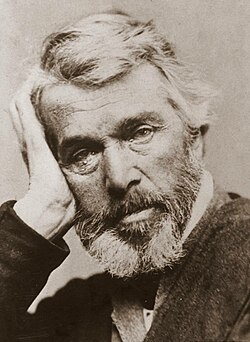
Back توماس كارليل Arabic توماس كارليل ARZ Tomas Karleyl Azerbaijani توماس کارلایل AZB Томас Карлайл Byelorussian Томас Карлайл BE-X-OLD Томас Карлайл Bulgarian টমাস কার্লাইল Bengali/Bangla Thomas Carlyle BS Thomas Carlyle Catalan
Thomas Carlyle | |
|---|---|
 Portrait c. 1865 | |
| Born | 4 December 1795 Ecclefechan, Dumfriesshire, Scotland |
| Died | 5 February 1881 (aged 85) London, England |
| Spouse | |
| Education | |
| Alma mater | University of Edinburgh |
| Philosophical work | |
| Notable ideas | |
| Signature | |
 | |
| This article is part of a series on |
| Conservatism in the United Kingdom |
|---|
 |
Thomas Carlyle (4 December 1795 – 5 February 1881) was a Scottish essayist, historian, and philosopher. Known as the "sage of Chelsea", his writings strongly influenced the intellectual and artistic culture of the Victorian era.
Carlyle was born in Ecclefechan, a village in Dumfriesshire. He attended the University of Edinburgh where he excelled in mathematics and invented the Carlyle circle. After finishing the arts course, he prepared to become a minister in the Burgher Church while working as a schoolmaster. He quit these and several other endeavours before settling on literature, writing for the Edinburgh Encyclopædia and working as a translator. He initially gained prominence in English-language literary circles for his extensive writing on German Romantic literature and philosophy. These themes were explored in his first major work, a semi-autobiographical philosophical novel entitled Sartor Resartus (1833–34).
Carlyle eventually relocated to London, where he published The French Revolution: A History (1837). Its popular success made him a celebrity, prompting the collection and reissue of his earlier essays under the title of Miscellanies. His subsequent works were highly regarded throughout Europe and North America, including On Heroes (1841), Past and Present (1843), Cromwell's Letters (1845), Latter-Day Pamphlets (1850), and Frederick the Great (1858–65). He founded the London Library, helped establish the National Portrait Galleries in London and in Edinburgh,[1] became Lord Rector of the University of Edinburgh in 1865, and received the Pour le Mérite in 1874 among other honours.
Carlyle occupied a central position in Victorian culture, being considered the "undoubted head of English letters"[2][3] and a "secular prophet". Posthumously, a series of publications by his friend James Anthony Froude damaged Carlyle's reputation, provoking controversy about his personal life and his marriage to Jane Welsh Carlyle in particular. His reputation further declined in the aftermaths of World War I and World War II, when his philosophy was seen as a precursor of both Prussianism and fascism. Growing scholarship in the field of Carlyle studies since the 1950s has improved his standing, and though little-read today, he is yet recognised as "one of the enduring monuments of [English] literature".[4]
- ^ "The Great Hall in the Scottish National Portrait Gallery". National Galleries of Scotland. Retrieved 7 August 2022.
The procession starts with the author and historian Thomas Carlyle, who played a significant role in the establishment of the Scottish National Portrait Gallery, and the National Portrait Gallery in London.
- ^ Emerson, Ralph Waldo (1881). "The Literary Work of Thomas Carlyle". Scribner's Monthly. No. 22. p. 92. hdl:2027/uc1.32106009632289.
Mr. Carlyle ... has yet for many years been accepted by competent critics of all shades of opinion as the undoubted head of English letters.
- ^ Stephen 1887, p. 124, "Carlyle during these years had become the acknowledged head of English literature."
- ^ Tennyson 1973, p. 35.